Select Building Products/Retrofit for Fire Resilience
There are many building supplies and methods that are promoted to help improve your home's fire resilience. But which are most cost effective? And which might not actually work?
There is not always a simple answer, but we hope this page will help. You can also consult The Office of the California State Fire Marshal's (SFM) Building Materials Listing Program (BML)
For new homes,
California Building Code (2016) Chapter 7A, Materials and Construction Methods for Exterior Wildfire Exposure, provides minimum standards that must be followed for areas like ours where fire hazard risk is moderate to very high. Information below is organized by specific areas of the house.

For existing homes,
Products and methods that are specifically designed for retrofits are also described here, with links to reviews when available. Familiarity with Chapter 7A is useful as well. Even though you won't be rebuilding your whole house, it can be informative to know what is required of new homes.
Skylights Siding Decks and Porches
Eaves and Vents Windows Fences
Much of the information on this website is summarized from two excellent, detailed resources:
Home Survival in Fire Prone Areas, UCANR Publication 8393, 2010 , by University of California, Agriculture and Natural Resources
California Wildfire Retrofit Guide- Protect Your Property From Wildfire by the Insurance Institute for Business and Home Safety, a nonprofit, scientific research and communications organization funded by property insurers.

Roof- The vulnerable top of your home- subject to a raining of embers
Inspect it regularly, maintain it when necessary, and replace it when needed.
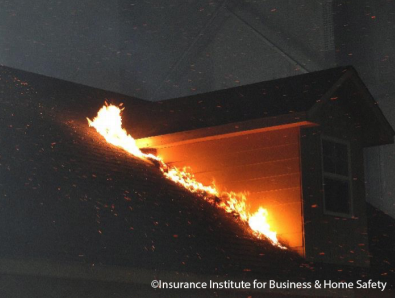
- Regular maintenance: Keeping leaves and pine needles off your roof on a regular basis (even weekly in Fall) may be the single most important thing you can do to keep your home form igniting during a wildland fire. Watch for and replace any missing shingles as well.
- Complex roofs, with dormers, etc.: Any areas where vertical wood meets your roof are particularly vulnerable. Dry leaves and other tinder can collect there, and then ignite the flammable wall adjacent. Non-flammable siding may be a good investment here.
- Roof replacement: This is a major, costly effort, but may be worth it if you have an old, poorly rated roof that will need to be replaced soon anyway. Roof materials are rated, ranging from the worst- "unrated" (such as untreated wood shingle), to Class C, B, or A. Class A roofs are the most fire resistant and strongly recommended. They can be of several different materials, such as asphalt composition shingles, clay, tile, metal etc. It can be hard sometimes to figure out just what classification an existing roof has - you may need to have it inspected to find out.
Your Roof edge can be vulnerable to embers, especially if dried out plywood is exposed. Here are some things you can do to reduce your risk:
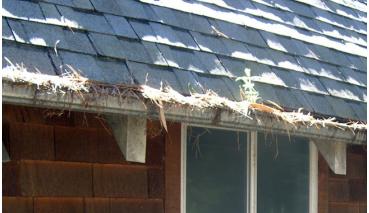
No accumulation of needles, leaves etc. in nearby gutter
No gaps in roofing at edge, such as can occur at end of clay tiles
Metal angle flashing covers roof edge
Gutter covers roof edge, rather than hanging below with edge exposed
Skylights- More vulnerable than the rest of your roof- don't neglect these
Skylights do not meet Class A roof standards, whether they are flat and tempered glass, or domed and plastic (with glass inside). ANR publication 8393 page 5
It is critical that skylights be closed when there is a risk of fire. They also need to be cleaned regularly, including along their edges. And any overhanging branches should be removed- these could fall onto the skylight during a fire and break it, allowing fire to enter your home.
Eaves and Vents- Important potential for access of embers into your attic,
Summary of findings from recent vent studies- source: firesafemarin.org
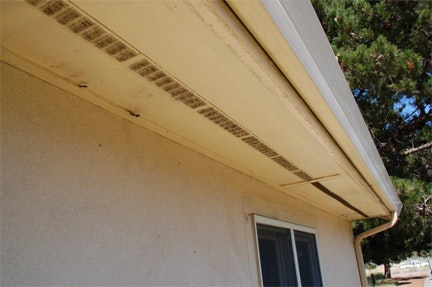
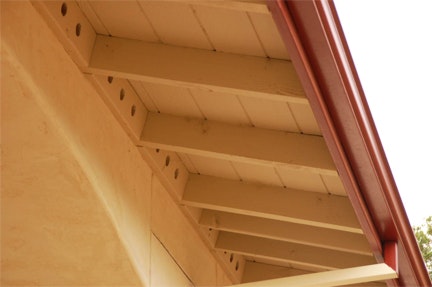
- Soffited eave construction preferred: There are two options for inlet vents, both located in the under-eave area. These include vents in the between-rafter blocking in open-eave construction (left) and vents in the soffit material in soffited-eave construction (right). Vents located in soffited-eave construction were shown to help limit ember entry and should therefore be the preferred construction type. Retrofitting soffits can be a major project. however. For open eaves, caulking any gaps that lead into the attic and adding fine mesh metal screening to vents can help significantly, as can keeping vegetation at least 5 feet away.
- Use 1/8 (3 mm) to 1/16 inch (1.5 mm: mosquito screen size) metal mesh screen over vents The older standard ¼-in. (6 mm) mesh screening should not be used to cover any vent. The finer 1/16-in. mesh screen is best at preventing ignition from embers but may require more cleaning-related maintenance to remove the debris that can accumulate on the screen surface. Bronze or stainless steel screening is preferred over aluminum or fiberglass. Be sure not to allow paint to fill holes. See more on screening below.
- For gable ends, consider using/replacing with specifically designed wildfire-resistant vents They performed better in recent studies than screen mesh alone. A wildfire-resistant gable vent that has passed ASTM E2886 should be used. These vents passed California standards as of 2018:
-Vulcan vents- screens on both sides, and a honeycomb that melts with heat to close
-Elite vents (they also have a filter that can be added to existing louvered gable vents)
-Brandguard vents- unique baffle design. Does not require heat to work. - Or, avoid gable end events altogether, if you can, due to the relatively large size and vertical orientation. But be sure you still allow for proper air flow out of your attic.
- For off-ridge and ridge vents, use wildfire-resistant vents. Of the ridge and offridge outlet vent options, the following performed well:
-Miami-Dade wind-driven-rain-compliant ridge vent
-Wildfire-resistant off-ridge vent
-Turbine (off-ridge) vent - Try not to use vents with plastic components, as is commonly used in ridge vents. If you have those, regularly remove any wind-blown vegetative debris from their inlets.
More details of the study: Vulnerability of vents to wind-blown embers, Quarles, Steven L., 2017, IBHS
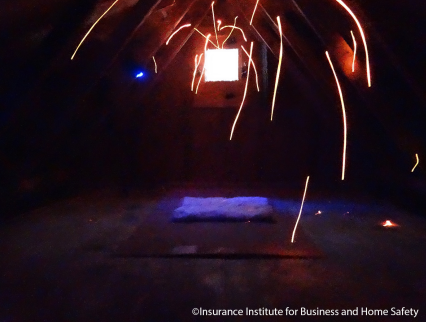
What's In Your Attic?
Even with screening and/or baffles, some (possibly even many) small embers may enter your attic. Will they hit fuel? Are you storing paper, cardboard, or other flammables there? Attics tend to be very hot, dry places. Don't let yours act as a tinder box when a fire is nearby!
Keep your attic clean and strongly consider storing only non flammable items there. If your vent mesh is strong, fire resistant, and has small holes (1/16 inch), any embers entering the attic will also be small and will not likely have enough energy to ignite roofing lumber or fiberglass insulation.
Gutters- Clean regularly, consider guards
In fact regular cleaning is more important than what the gutter is made of:
- A metal gutter will not burn, but will hold any debris close to your roof edge, risking ignition.
- A vinyl gutter can melt and fall, which moves the debris hazard to ground level and vegetation there
Either way- clean debris out of your gutter regularly!
What about gutter guards?
Gutter guards attempt to divert water into the gutter, without letting debris in. . A lot of different brands and types are available, with varying reviews.
Some cover the gutter with a screen to catch debris, some cover the gutter with a thin metal sheet letting water enter the gutter through a gap, some use a combination metal sheet with louvers, and some use a porous foam to fill the gutter, allowing only water through. Many require that you have them professionally installed.
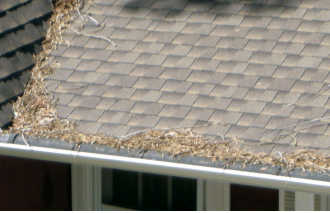
Unfortunately, there is no good standard that these devices must meet, and it is recommended that you read reviews before purchasing. Some people swear by them, and some are not so happy.
None are completely maintenance free. You still need to be vigilant and remove debris where it might collect behind the device, or even in your gutter. If there are trees near your roof, maintenance may need to be done many times a year, whether you have guards or not.
Watch a short consumer reports video on gutter guards
Tip: During red flag warning conditions, stop up your downspout (with a tennis ball, wadded wet t-shirt, or pre=cut foam bung) and fill your gutters with water. Any embers that land there will likely be extinguished. Be sure to drain gutters afterwards to prevent mosquitoes.
ANR publication 8393, page 6
Siding- Consider installing fireproof siding in specific areas
Siding that will not burn (non-combustible) exists, and installing such siding is certainly good. But as a retrofit, other measures, such as creating defensible space and screening vents, may be more cost-effective. especially if you are on a limited budget.
One possibility is to install non combustible siding only in vulnerable areas- right behind a bush you can't bear to remove, next to a complex roof, at an inside corner of your exterior wall, on a wall that faces a vegetation choked canyon, etc.
Or, if you are in the very high hazard zone of our area, you might want to consider non-combustible siding more seriously. Find your hazard zone here.
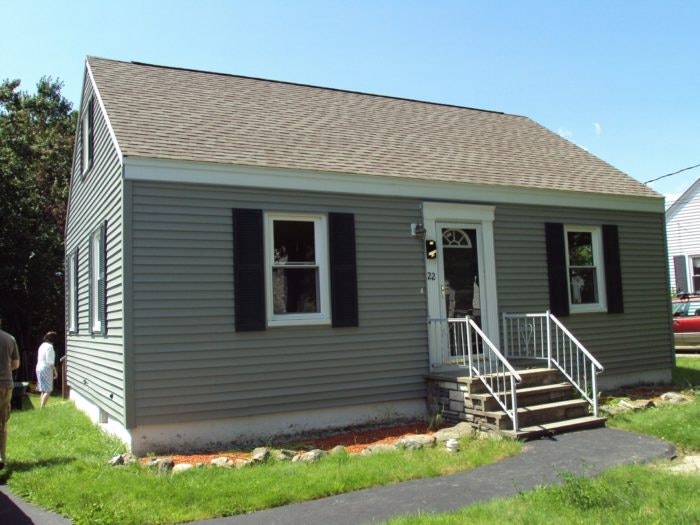
First step, for everyone:
Be sure all your siding starts at least 6 inches up from the ground, and that you have nonflammable ground and no vegetation or flammable furniture 0-5 ft out- instead have bare dirt, concrete, rock path etc. This is highly effective at reducing the chances of your siding, and then your home, catching on fire. See disastersafety.org, IBHS
Second step, if you choose to replace some or all of your siding choose carefully.
Make sure too that you don't introduce a ledge between new siding and old, where embers can collect!
There are three classes of siding:
Non-combustible (won't burn easily): The best class to use. Examples:
- Concrete
- Fiber-cement- Read about fiber cement and its advantages here
- Three-coat stucco,
- Metal siding
- Masonry
- Stone or "cultured stone" veneer, provided all gaps are mortared or caulked
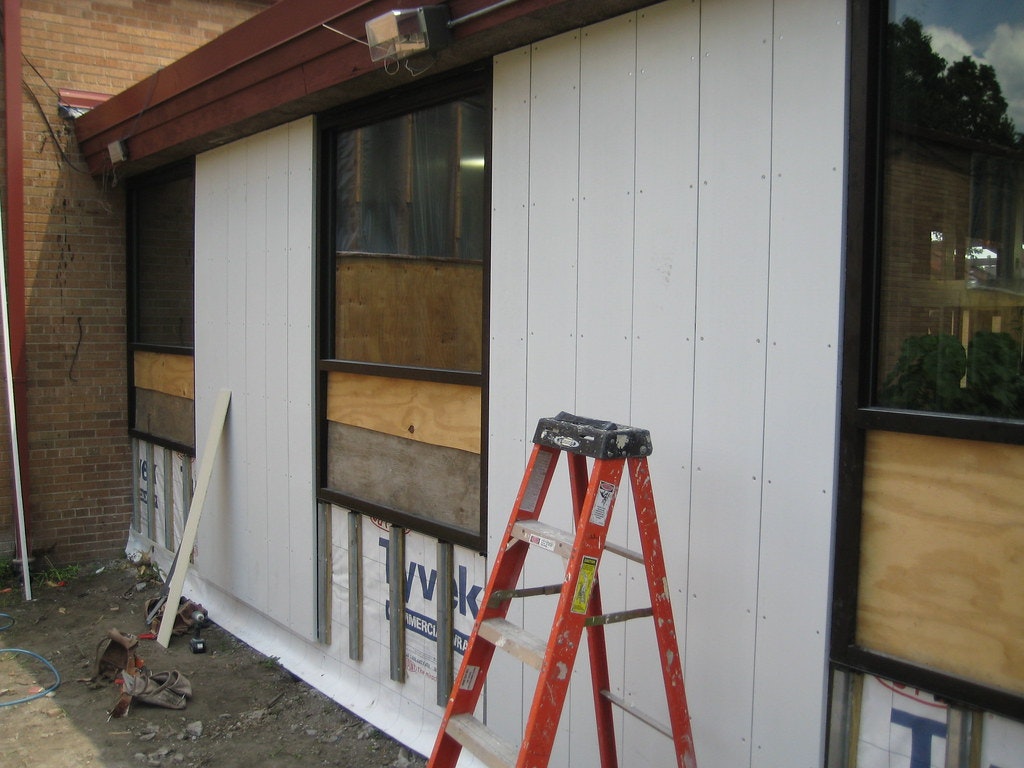

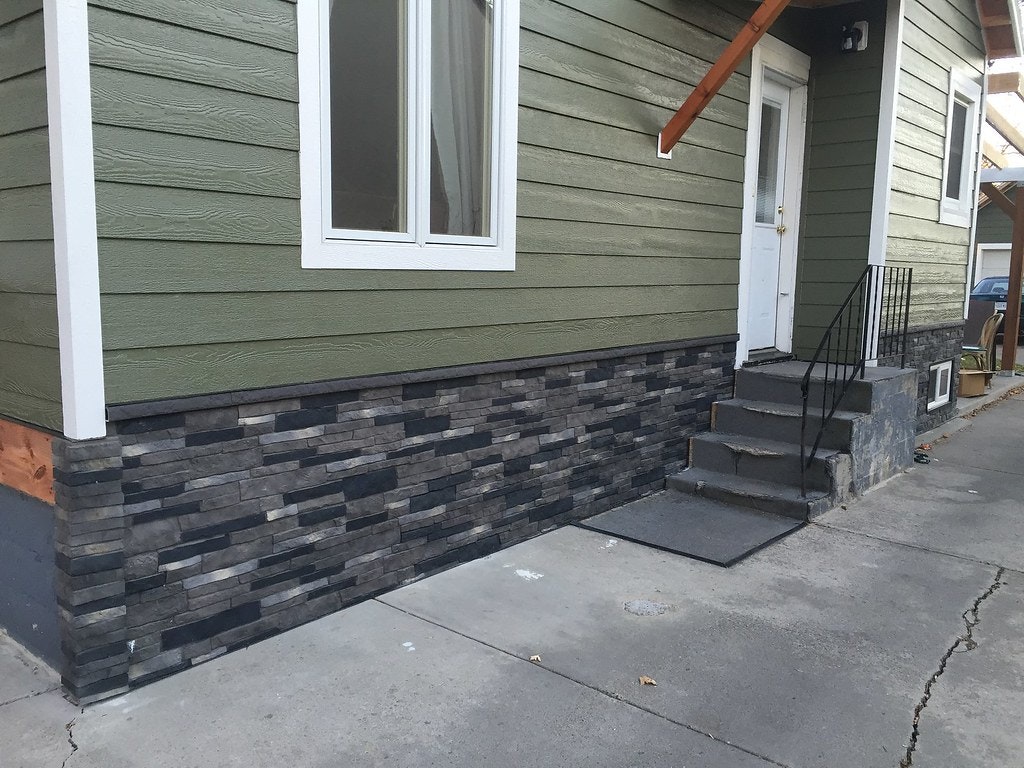
Ignition resistant (isn't supposed to catch on fire easily): May not have long term effectiveness
- wood siding treated with exterior fire-retardant or coating-
These are not considered to be effective over the long term, due to weathering and drying. Read more here, and here.
Combustible or Susceptible to melting: Avoid, and consider replacing if already there in vulnerable areas, such as within 6 inches of ground, next to an inside corner, next to roof, behind a shrub, etc.
- Wood
- Plywood
- Compressed wood fiber (a popular low cost siding in the 1980's and 1990's). Not to be confused with fiber-cement, which is non combustable. Not sure what you have? Determine whether your house has compressed wood fiber siding
- Vinyl (see FEMA recommendations against)
Windows- Vulnerable to breakage from radiant heat
The first line of defense is to be sure ALL windows are securely closed if fire hazard conditions exist. Be sure not to forget garage and bathroom windows, so that embers and/or flames can not easily enter your home. .
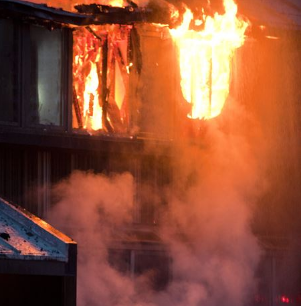
Even windows that are shut can be a hazard. The same way that windows let more heat out during the winter than walls, they also let more heat in during a fire- worst of all they can break if they can't handle the stress on the glass from radiant heat. To reduce that risk:
- Double or triple paned windows are much more break resistant than single pane
- Tempered glass is better than the annealed glass typically used in windows
- If you have double paned windows, one pane may be tempered. Look in corner of window for glass details.
- Vegetation in front of windows is not a good idea, as it can catch on fire and greatly increase the radiant heat that the windows must withstand.
What about framing material?
While the glass is shown by some studies to be the most vulnerable part of a window, the framing of the window can make a difference too. Results are not cut and dried however as to which is safest.
Windows can be wood, vinyl, aluminum, wood that's clad in vinyl or aluminum, or fiberglass. And the parts inside a window can be flammable themselves, such as the pulley system for a double hung window.
Some guides recommend against Vinyl (including FEMA 2008), but when these windows have a reinforcing bar as they often do, they might not be any more vulnerable than other framing types. Vinyl windows that are certified to meet AAMA/WDMA/CSA 101/LS2/A440 standard specifications have this feature.
For a more detailed discussion of windows see UCANR publication 8393 page 11
Screening- Use metal with 1/8-1/16" holes (1/16" is preferred)
Window screens can help reduce the radiant heat a window is exposed to, They can also prevent large embers from entering your home if window glass breaks. They may not help enough though in the case of direct flame exposure, such as from burning vegetation directly outside the window.

Bronze and stainless steel screening are more difficult to find, but are more effective than the cheaper, commonly available fiberglass or aluminum. (Aluminum screens, though metal, actually fared worse than fiberglass at reducing radiant heat exposure in one study. UCANR Publication 8393 page 13)
You may need to find these sturdy screening types online, or order them from a local window or hardware store.
Another effective option to consider are exterior window shutters. Because of the vertical orientation, these can even be wood, as long as they are simple and don't have ledges for embers to accumulate on.
Mesh size
Mosquito sized mesh, 1/16 inch, is what windows generally use. 1/16 inch is effective at limiting the size of embers to a size small enough that they are unlikely to have enough energy to ignite flammable materials.
Decks and Porches- Ways to reduce their fire hazard
Decks and porches can ignite when embers fall on their floor surface, and also when embers ignite things stored on the deck ( wooden furniture, decorations, etc.) or under the deck (old wood, junk etc.). Wood that is well weathered or even rotten can be particularly vulnerable to catching fire. Deck/porch fires can draw fire to your home if, like most, they are attached to the main structure.
There are several approaches you can take:
- Detach your deck from your house or replace with raised patio. Use nonflammable furniture.
This can be a simple, cost effective approach, especially if your deck is low to the ground, and/or in need of replacing anyway. Keeping a wooden deck even 10 feet away from your house with a concrete, brick or rock patio inbetween can help keep a deck fire from igniting your home.
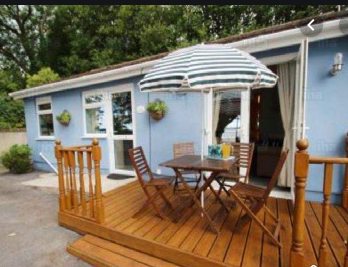

- Replace your deck with non flammable materials. This might mean replacing decking and structure alike with aluminum, steel or lightweight concrete.
Examples:
Fortress Building Products (steel posts, beams, joists and railings)
For more on fire resistant decks, which can be expensive, see This Old House
For more on making your deck fire resistant, Fire Safe Marin
Fences- Don't let these act as a fuse, bringing fire to your house
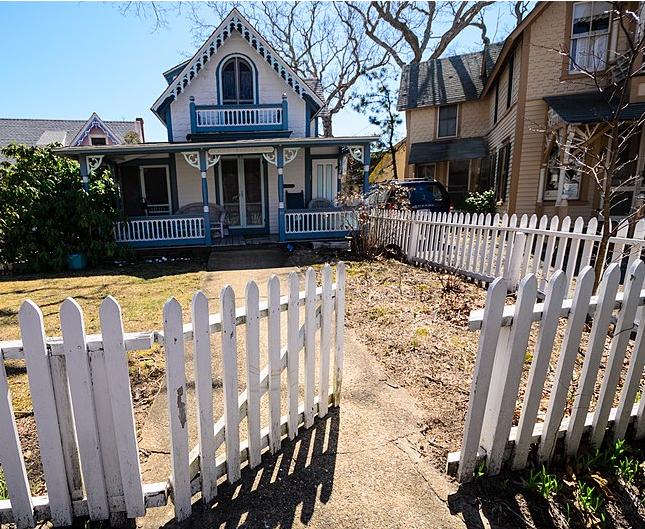
Some methods to prevent fences from bringing fire to a house::
- Replace with a non flammable fence, such as metal
- Replace the last 5 feet next to the house with non flammable materials
- Have the fence stop at least 5 feet before reaching the house.
- If there is a gate near the house, open it during red flag warning times, to reduce risk by breaking up the path of a potential fire.
